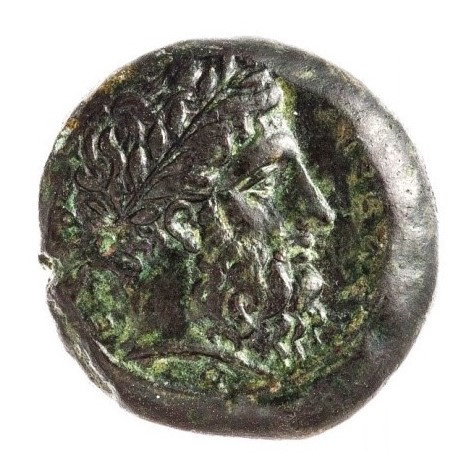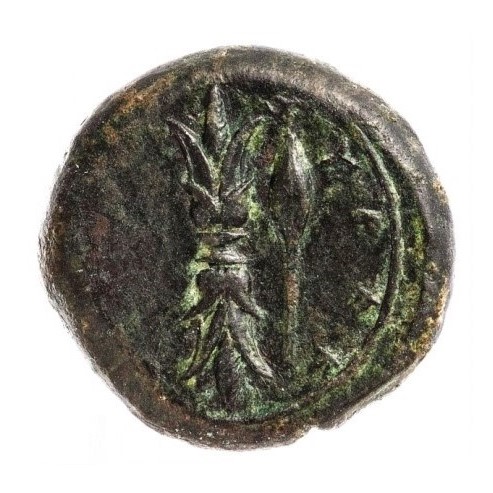Title: Hemilitron of Timoleon of Syrakousai (Syracuse) - 1981.04
Acquisition number: 1981.04
Author or editor: Douglas Kelly
Culture or period: Classical Greece.
Date: c. 344-336 (or c. 317 BC).
Material: Metal - Bronze
Object type: Coins - Greek
Dimensions: 22mm (w)
Origin region or location: Italy
Origin city: Syrakousai (Syracuse)
Display case or on loan: 5
Keywords: Coin, Greek, hemilitron, Timoleon, Zeus, Zeus Eleutherios, Sicily, Syrakousai (Syracuse), Olympian Zeus
R.J.A. Talbert, Timoleon and the Revival of Greek Sicily 344-317 B.C. (Cambridge, 1974).
R. Calciati, Corpus Nummorum Siculorum: La Monetazione di Bronzo, 3 vols (Milan, Edizioni GM, 1983-1987), 71.
O. Hoover, Handbook of Greek Coinage 13 vols (Classical Numismatic Group, Lancaster, PA, 2009-2013), vol.2, 440.
Classical Numismatic Group Auction, 97 lot 43.
1981.04
Hemilitron of Timoleon of Syrakousai (Syracuse)
Bronze, 16.15 g. 22 mm. c. 344-336 (or c. 317 BC)
Obv.: Head of Zeus Eleutherios,
Rev.: Thunderbolt above ear of wheat
After the collapse of the tyranny of Dionysios II of Syrakousai in 456 BC, the Greek cities of Sicily suffered severely from civil war, from various attempts at re-establishing the tyranny, and from Carthaginian attacks. An appeal for help from Syrakousai to its mother-city Corinth led to the appointment of Timoleon in charge of a small volunteer force. Against all expectations Timoleon reconciled feuding factions, expelled tyrants, and led the united Sicilian Greeks to a great victory over an invading Carthaginian army at the River Krimisos in c. 343 BC.
Timoleon resettled a number of Greek cities that had been depleted or destroyed in the wars or by the migration of populations imposed by tyrants in the previous sixty years (cf. 1980.03, Akragas). In the conditions of peace that Timoleon created there was a major influx of new settlers from mainland Greece into the Greek cities of Sicily. A revival of the region is attested by the archaeological record and also by the great increase in the number and the volume of Sicilian coinage issues.
Timoleon established orderly constitutional government in the cities (this was not, however, democracy on the Athenian model). He founded a new cult of Olympian Zeus at Syrakousai: Zeus Eleutherios (Zeus the Deliverer) was ideal as the presiding deity of this new civic order that resulted from liberation from foreign enemies and tyranny. The head of this Zeus, together with the thunderbolt, Zeus’s weapon and his common attribute, appear on much of the coinage of Sicily at this time. The ear of wheat on the reverse may be taken as a symbol of peace and prosperity.
Timoleon died c. 335-330 BC, some 15 years or so before Agathokles seized power in Syrakousai and Sicily reverted to a period of tyranny and conflict.
R.J.A. Talbert, Timoleon and the Revival of Greek Sicily 344-317 B.C. (Cambridge, 1974).
R. Calciati, Corpus Nummorum Siculorum: La Monetazione di Bronzo, 3 vols (Milan, Edizioni GM, 1983-1987), 71.
O. Hoover, Handbook of Greek Coinage 13 vols (Classical Numismatic Group, Lancaster, PA, 2009-2013), vol.2, 440.
Classical Numismatic Group Auction, 97 lot 43.

